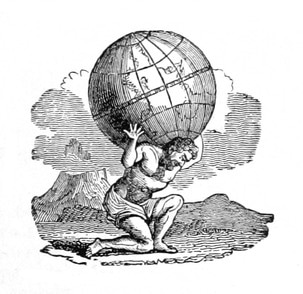Panodorus
c. 412 CE
trans. in the Popular Biblical Educator
1855
|
NOTE |
Panodorus was a Christian monk in Byzantine Alexandria in the early fifth century CE, a biographical sketch of whom I have included below from the Dictionary of Christian Biography. He wrote an influential world chronicle covering history from the creation to the death of the bishop Theophilus in 412 CE. This chronicle, which survives only in a handful of references in the ninth century chronicle of George Syncellus, was particularly important because it was the first to incorporate the Watchers from 1 Enoch into a chronology of world history and to use them to harmonize Christian, Egyptian, and Babylonian chronologies. The chronicle of Panodorus served as the basis for that of Annianus, which was a key source for Arab-Islamic writers, influencing medieval Hermetic and pyramid mythology, through which its influence continues to be felt today.
The fragments below represent what survives of the antediluvian sections of the chronicle of Panodorus, which, to judge by the fragments of Annianus, also included excerpts from the Book of Enoch and other key sources as part of a complex and lengthy historical narrative. Sadly, medieval people did not care much for length and preserved little of the text. |
|
PANODORUS, an Egyptian chronologer, who wrote at the beginning of the 5th century. He is almost exclusively known to us through the use made of his work by Georgius Syncellus, who states (p. 617, 18, Bonn edition) that Panodorus was an Egyptian monk who flourished in the reign of Arcadius (A.D. 395-408), and in the episcopate of Theophilus, the 22nd bishop of Alexandria, who died A.D. 412. Syncellus usually names Panodorus in company with another Egyptian monk and chronologer, Anianus; and states (pp. 61, 3; 62, 2) that the two were contemporary. He describes (62, 18) the work of Anianus as the more concise, and as agreeing with the tradition of the apostles and holy fathers. It contained Easter tables in 11 cycles of 532 years each, and probably contained little more than historical notes accompanying these tables. It placed the Incarnation on the 25th March at the end of the year of the world 5500, the same day being set down for the date of the Creation and of the Resurrection. The work of Panodorus on the other hand was fuller and more various, and exhibited greater knowledge of profane writers. He counted the years before the Incarnation as 5493 years instead of 5500. Unger has given reasons for concluding that the date of the death of the bishop Theophilus, which Syncellus quotes anonymously (p. 59, 5), was really taken from the work of Anianus. This work therefore must have been later than 612; and therefore the work of Panodorus, written in the reign of Arcadius, must have been the earlier of the two. The sources whence Panodorus chiefly derived his profane history were the works of Africanus, of Eusebius, and of Dexippus. Panodorus frequently criticizes Eusebius with great severity. A list of the principal points on which he founds censure will be found in the work from which most information about Panodorus can be obtained, viz. Gelzer’s Sextus Julius Africanus und die Byzantinische Chronographie. Panodorus shows great interest both in Egyptian and in Chaldee learning, which he endeavours to harmonize with the scriptures, reconciling the long Chaldee chronology with the shorter chronology of the Hebrews, by the hypothesis that the Chaldee years were only days. Gelzer imagines that Panodorus was one of the Neo-Platonists who, by the end of the 4th century, had made their peace with the church, and who strove to incorporate with Christianity some of the ancient learning, on which they set the highest value.
-- George Salmon, Dictionary of Christian Biography |
The Antediluvian Fragments of Panodorus’ World Chronicle
Excerpt 1
From Syncellus, Chronicle 41-42
After speaking of the mode of interpreting the books of Hermes, Manetho proceeds to give an account of the five Egyptian races which reigned in thirty dynasties, viz. those styled by them Gods and Demigods, and the Manes and the Mortals. Of these Eusebius Pamphilus also makes mention in his chronicle, where he speaks thus: ‘The Egyptians spin a long and foolish mythological story concerning their Gods and Demigods, and besides these, the Manes and other Mortal kings. For the most ancient of these kings used to call mouths consisting of thirty days, years; and the demigods after these used to style seasons of three months, years.’ This is what Eusebius has very properly written in censure of the vain tales of the Egyptians, and Panodorus had no right, as I think, to take him to task for being at a loss how to elucidate the sense of their historians, which he flatters himself he is able to explain thus: ‘From the creation of Adam,’ he says, ‘to Enoch,’ which, as we say, was the common year of the world, 1286, ‘men knew not the number of the days of either the mouth or the year. But the Egregori,’ who, as we affirm, descended upon earth and began to converse with men in the common year of the world, 1000, ‘taught them concerning the orbits of the two luminaries, and their division into the twelve signs of the zodiac and into three hundred and sixty degrees. But men fixing their attention upon the lunar orbit of about thirty days, as being the lesser and the nearer to the earth of the two, as well as the more obvious one, determined to make this the measure of their year, pitching upon this instead of the solar orbit, which is also completed in twelve signs and three hundred and sixty equal degrees. Whence it came to pass that the reigns of the gods who reigned amongst them through six races and as many dynasties, are numbered in years consisting of lunar revolutions of about thirty days. The sum of these month-years which they make is 11,985, which come to 969 solar years. When you have added these to the 1,058 years which elapsed before the beginning of the kingdom of which the Egyptians speak, you obtain the sum of 2,027 years.’
In like manner, Panodorus is at the pains to extract 214½ years out of the 858 three-monthly seasons of the nine demigods arranged in two dynasties; I mean those imaginary demigods; as though, forsooth, they were not imaginary. Accordingly, with the 969 years, the sum of 1,183½ years is made up, which, being themselves added to the 1,058 years interposed between Adam and the reign of the gods, fill up the space of 2,242 years to the Deluge.
In this way, then, Panodorus endeavours to demonstrate that the Egyptian books, which are quite at issue with our inspired and sacred books, may be reconciled with them, passing censure upon Eusebius. But he has overlooked the fact that he himself has attempted to establish against himself and against the truth these accounts, which cannot be clearly demonstrated by any process of reasoning. For neither had Babylon and Chaldea any kings before the Deluge, nor Egypt before Mizraim, nor, as I think, was it inhabited at all before that time.
Excerpt 2
Syncellus, Chronicle 18
Manetho, the Sebennyte priest of the polluted rites of Egypt, who lived after Berosus under Ptolemy Philadelphia, weaving together lies, like Berosus, writes to this Ptolemy concerning six dynasties, or concerning seven (six) gods who never existed, who, he says, reigned 11,985 years. The first of them, the god Hephaestus, reigned 9,000 years. But these 9,000 years some of our historians (i. e. Panodorus and his emulators), reckoning as so many lunar months, and dividing the number of days which are contained in these 9,000 months by 365, the number of days in a solar year, obtain thus 727¾ years, and in this way they flatter themselves that they have made a grand discovery, whereas they have only attempted to blend with the truth a lie which deserves to be received with nothing better than laughter.
From Syncellus, Chronicle 41-42
After speaking of the mode of interpreting the books of Hermes, Manetho proceeds to give an account of the five Egyptian races which reigned in thirty dynasties, viz. those styled by them Gods and Demigods, and the Manes and the Mortals. Of these Eusebius Pamphilus also makes mention in his chronicle, where he speaks thus: ‘The Egyptians spin a long and foolish mythological story concerning their Gods and Demigods, and besides these, the Manes and other Mortal kings. For the most ancient of these kings used to call mouths consisting of thirty days, years; and the demigods after these used to style seasons of three months, years.’ This is what Eusebius has very properly written in censure of the vain tales of the Egyptians, and Panodorus had no right, as I think, to take him to task for being at a loss how to elucidate the sense of their historians, which he flatters himself he is able to explain thus: ‘From the creation of Adam,’ he says, ‘to Enoch,’ which, as we say, was the common year of the world, 1286, ‘men knew not the number of the days of either the mouth or the year. But the Egregori,’ who, as we affirm, descended upon earth and began to converse with men in the common year of the world, 1000, ‘taught them concerning the orbits of the two luminaries, and their division into the twelve signs of the zodiac and into three hundred and sixty degrees. But men fixing their attention upon the lunar orbit of about thirty days, as being the lesser and the nearer to the earth of the two, as well as the more obvious one, determined to make this the measure of their year, pitching upon this instead of the solar orbit, which is also completed in twelve signs and three hundred and sixty equal degrees. Whence it came to pass that the reigns of the gods who reigned amongst them through six races and as many dynasties, are numbered in years consisting of lunar revolutions of about thirty days. The sum of these month-years which they make is 11,985, which come to 969 solar years. When you have added these to the 1,058 years which elapsed before the beginning of the kingdom of which the Egyptians speak, you obtain the sum of 2,027 years.’
In like manner, Panodorus is at the pains to extract 214½ years out of the 858 three-monthly seasons of the nine demigods arranged in two dynasties; I mean those imaginary demigods; as though, forsooth, they were not imaginary. Accordingly, with the 969 years, the sum of 1,183½ years is made up, which, being themselves added to the 1,058 years interposed between Adam and the reign of the gods, fill up the space of 2,242 years to the Deluge.
In this way, then, Panodorus endeavours to demonstrate that the Egyptian books, which are quite at issue with our inspired and sacred books, may be reconciled with them, passing censure upon Eusebius. But he has overlooked the fact that he himself has attempted to establish against himself and against the truth these accounts, which cannot be clearly demonstrated by any process of reasoning. For neither had Babylon and Chaldea any kings before the Deluge, nor Egypt before Mizraim, nor, as I think, was it inhabited at all before that time.
Excerpt 2
Syncellus, Chronicle 18
Manetho, the Sebennyte priest of the polluted rites of Egypt, who lived after Berosus under Ptolemy Philadelphia, weaving together lies, like Berosus, writes to this Ptolemy concerning six dynasties, or concerning seven (six) gods who never existed, who, he says, reigned 11,985 years. The first of them, the god Hephaestus, reigned 9,000 years. But these 9,000 years some of our historians (i. e. Panodorus and his emulators), reckoning as so many lunar months, and dividing the number of days which are contained in these 9,000 months by 365, the number of days in a solar year, obtain thus 727¾ years, and in this way they flatter themselves that they have made a grand discovery, whereas they have only attempted to blend with the truth a lie which deserves to be received with nothing better than laughter.
SIX DYNASTIES OF GODS. |
YEARS. |
1. Hephaestus, reigned first over the Egyptians |
727¾ |
2. Helios, the son of Hephaestus |
80 1/6 |
3. Agathodaemon |
56 7/12 |
4. Cronus |
40 1/12 |
5. Osiris and Isis |
35 |
6. Typhon |
29 |
TOTAL |
969 |
TWO DYNASTIES OF DEMIGODS. |
YEARS. |
7. Orus |
25 |
8. Ares |
23 |
9. Anubis |
17 |
10. Heracles |
15 |
11. Apollo |
25 |
12. Ammon |
30 |
13. Tithoes |
27 |
14. Sosus |
32 |
15. Zeus |
20 |
TOTAL |
214 |
Source: "Biblical Chronology: Period I: From the Creation to the Deluge," Popular Biblical Educator, vol. 2 (London: John Cassell, 1830), 202-203.




